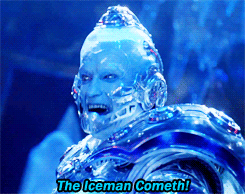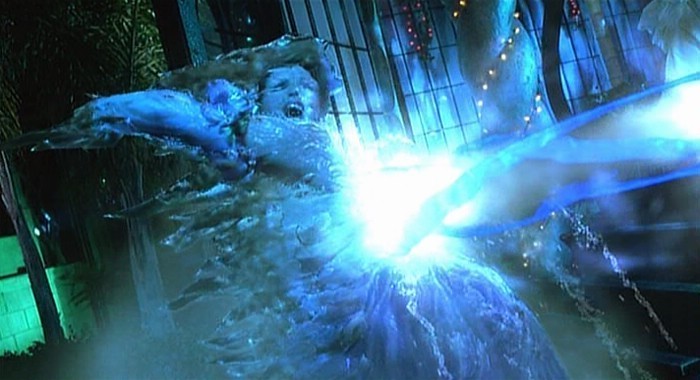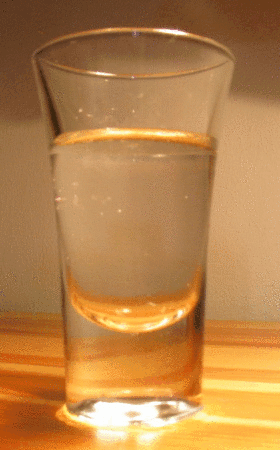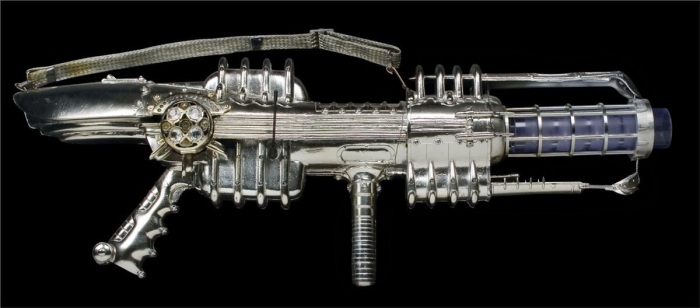Before I start, I have to make one thing perfectly clear. I fucking love Batman and Robin. It‘s so bad. But its enjoyment value exceeds any of the other Batman films made, in my humble opinion. The endless insufferable puns, its campy action scenes, the incredibly ominous architecture of Gotham wreathed around eyeless statues. But best of all. ARNOLD EFFING SCHWARTZENEGGER. I know his dialogue in the movie pretty much by heart and whenever I watch it, I practically scream along with his lines in my horrendously inept Schwarzenegger impression. But the thing that fascinates me most. His Freeze Gun.

Like, reeeeaaaaally bad puns.
The freezing gun shoots a cryogenic laser beam which freezes his victims, encapsulating them in ice. (According to the film, once a person is frozen by the gun you have exactly eleven minutes to thaw him/her in order to save his/her life. For brevity‘s sake I shall omit this silly point for now).
Okay, so could we make this work? Let‘s delve deeper.
The ice that forms around the victims of the freezing gun is in all likelihood, condensed water from the atmosphere. Like how water condenses on the windows inside your car when it‘s raining. But in order for the ice to form, we need to lower the temperature significantly so that the atmospheric water molecules are quickly aggregated around the victim, leaving it stupefied in ice. Lowering the temperature means that the kinetic energy of all of the gas phase molecules is lowered or dispersed. This is where we meet our first obstacle. The laws of thermodynamics.

Yubb. We’re gonna science the shit out of this ‘freeze-a-ma-jigg’.
The first law of thermodynamics states (in layman‘s terms) that energy can not be created, nor destroyed, it can only converted into a different form of energy. I.e. potential energy can be converted into kinetic energy, electrical energy can be converted into chemical energy, mass can be converted into nuclear energy (via E = mc2), etc. So, to decrease to temperature of all the atmospheric molecules, we can not destroy the excess energy, but perhaps we can convert it or displace it… somehow.
But then there‘s the second law of thermodynamics. The entropy of a system will always tend towards maximum. Or in other words, the universe‘s entropy always increases. Entropy is really a measure of the randomness of all of the infinitesimal constituents of any thermodynamic system. When an ice cube melts on a table, the newly liberated water molecules scatter over the table. If we freeze these water molecules again, they don‘t reemerge into an ice cube‘s lattice structure. Upon liquification, the water molecules had enough kinetic energy to randomly scour the table‘s surface. Randomly. Assuming the table‘s surface is relatively smooth and not under an incline, the water molecules don‘t all go in the same direction. They‘re randomly distributed. This randomness „makes sense to the molecules“ and this behavior epitomizes the second law. When a system is presented with a bundle of energy, the bundle is randomly distributed onto the system‘s substituents.

Yeah. No. This doesn’t happen.
So what does this mean for our freezing gun? Well, when the temperature locally decreases around the freezing beam we are decreasing the entropy around the victim, leaving it vulnerable to formation of killer ice cages. (Dramatic, right?) But that means that we have to increase the entropy of something else to drive the ice formation forward. I.e. fuel.
A freezing gun might employ some sort of cold liquid, like liquid helium, but considering how many targets Mr. (or Dr.) Friese manages to…freeze with the weapon indicates that this is unlikely. That amount of freezing liquid can not be stored in the gun itself. The gun itself does not either work as a reversed heat engine. I.e. that it employs absolute cold temperatures into which the atmospheric gas molecules are diverted to, via the freezing ray.

So, there’s no tank of liquid nitrogen?
Let‘s say that inside the freezing gun we have some ultracold reservoir. Opening up the gun‘s barrel then subjugates the ultracold reservoir to the atmosphere. Simple thermodynamics then dictate that the gaseous molecules surrounding the barrel will be the first one‘s to enter in order to reach some thermodynamic equilibrium. If we want the gaseous molecules around a target at a distance to be the first ones to enter the reservoir we need some sort of distance selective vacuum cleaner gadget… which is just plain silly. I mean let’s be serious about this Freeze Gun!
The answer: Laser cooling.
To answer your question. Yes, lasers can be used to cool things, just like they can be used to heat up things. A weird and funny thing about photons is that despite they have no mass, they do possess momentum. For those of you unaware, momentum equals the mass of an object multiplied with its velocity. Zero velocity equals zero momentum so zero mass equals zero momentum… or does it? Not in the quantum realm. Just google Heisenberg‘s uncertainty principle if you don‘t believe me.
A photon‘s momentum can actually be used to decrease an atom‘s velocity. If an atom moving in one direction clashes with a photon moving in the opposite direction, it will slow down the atom. This is how laser cooling works. By carefully tuning the laser‘s wavelength just longer than the required wavelength to achieve absorption by the non-moving atom, you can steadily slow down the atom against the direction of the laser beam. Check out this video by Physics Girl for details.
Physicists at MIT have achieved cooling down to under 1 K for as much as 1 g of matter. Of course in order to do this, they needed 6 separate laser beams to cool atoms in every single direction. If we were to scale this up with a freezing gun, we still would need cooling beams from five other directions. Or do we?

Even the laser cooling lab at Columbia university reminds you of the Freeze Gun!
The temperatures achieved by modern laser cooling are far lower than the temperature needed to freeze water. Did Mr. Friese hit upon precisely the right wavelength needed to freeze enough molecules to create a freezing domino effect around the frozen molecules? If you get enough molecules to form a cluster, that cluster might work as a reflective surface, scattering the beams into more directions, thus slowing down a greater number of molecules. A veritable domino effect. I may have to do some calculations.
Anyway. In principle, the freezing gun might be constructed one day. Which is cool. (Get it?)

HA. HA. HA. HA. (Sarcasm inferred)
On a tangent, I totally understand how a Nobel laureate would succumb to an endless torrent of terrible puns. He‘s a friggin scientist. The profession known for its appetite for bad jokes. Give a Nobel laureate the power to take over the world and he/she‘ll be spouting the dumbest shit you’ve ever heard. I totally buy it.

I just recently was thinking about this, but more towards actual creation of ice equipment (to fulfill a fantasy geek’s dream). So I was thinking about creating a frame of sorts that could freeze the water molecules in the air into the shape of a shield. Do you think this is possible? The mention of lasers slowing down atoms is something I haven’t heard of before, but that’s due to me just now thinking about this. Could you go into greater detail about how these work? I love your methodology of explaining things.
Also, since the shield idea does have a frame, technically there’s no need to worry about the ice beam actually traveling, all that’s needed is for the ice to form in the correct shape, and enough of it to actually qualify as something more than just a display piece. Since the “freeze beam” per se has no need to travel, could the shield work off another freezing mechanism?
Thanks for the interesting article. I look forward to your reply.
LikeLike